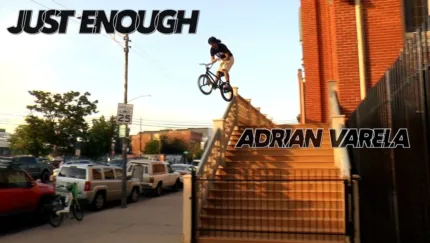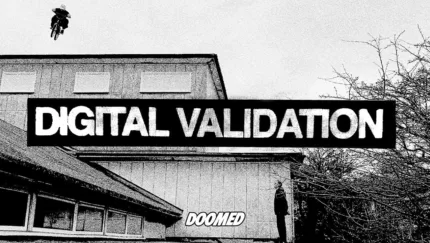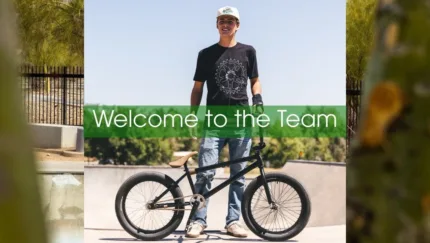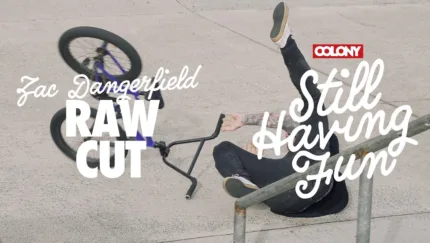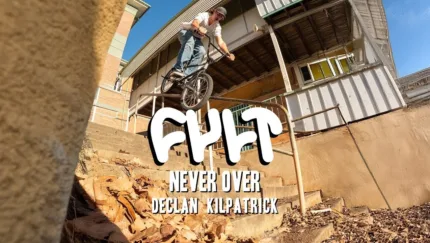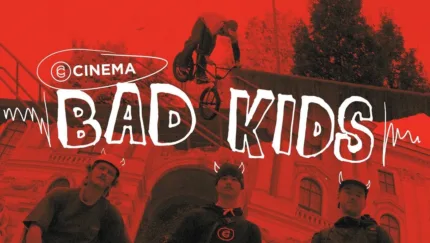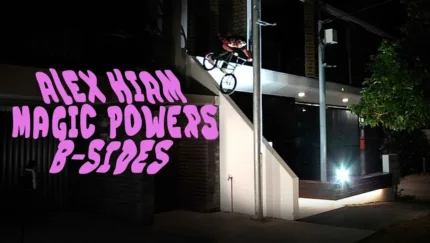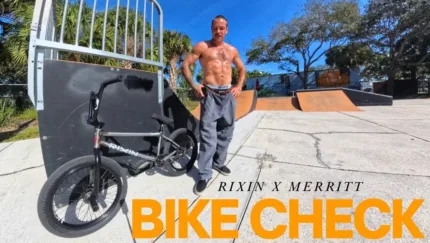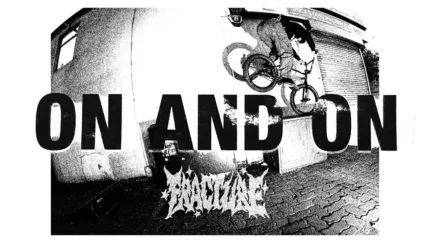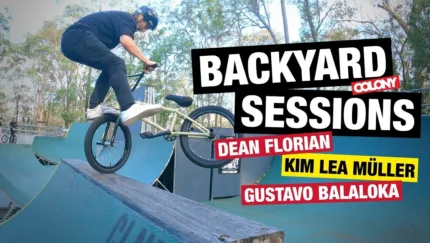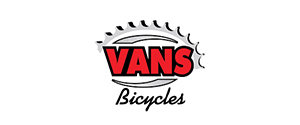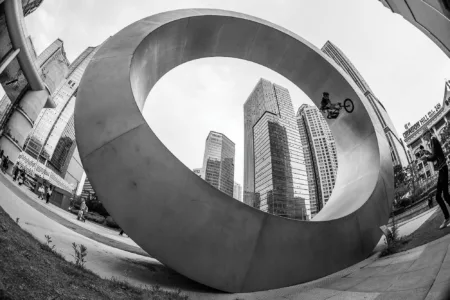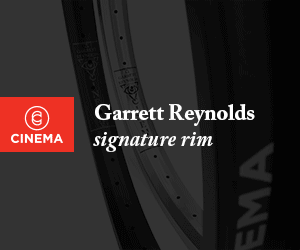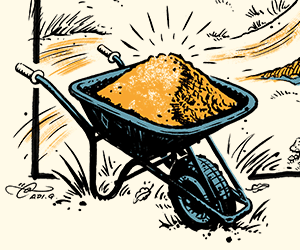
The Most Influential BMX* T-Shirt Companies of the 80's & 90's - PART 2
Remembering Lord Clothing, Scum, Anarchic Adjustment and many more...
Complied and written by Paul Covey (with additions from various DIG family members)
At one point in the late 80s and early 90s, the BMX industry was very small. How small? Well, small enough that the existing magazines would let practically anyone run an ad for their own D.I.Y. T-shirt venture for as little $100 a month (what goes around eh?). Following on from Part 1 we’ve included a few more brands here that are well worth mentioning for one reason or another. *Not all of these are even BMX companies as such but their influence at the time was immense and un-missable. If you've got any to add or images of any of the shirts that we're missing below then we'd love to hear from you.

Anarchic Adjustment
Anarchic Adjustment was based out of the UK, run by Nick Phillip (the guy who invented the wall ride, according to Eddie Roman and Dennis McCoy), and they made the raddest clothes. Raddest isn’t even a word according to my spell checker, but that’s just how rad Anarchic Adjustment was. After working at R.A.D. (Ride and Destroy) magazine, Nick Phillip had relocated to Southern California during the British BMX invasion of the late 80s and helped out with content at Freestylin’ and Club Homeboy magazines while pioneering cut and paste photocopy art and cultivating his unique brand of cutting edge clothing. Vision Street Wear had been around a while already, and they were massive. Life’s A Beach was also in there, but AA was the first “urban wear” rider-owned brand I really remember.


I loved looking at their raw ads and the black and white photos of their provocative t-shirts in Trend (now Empire BMX) advertisements. AA clothes were really amazing for the time…almost too ahead of their time. I didn’t personally feel like I could pull off wearing their designs at my middle school in rural Texas in 1989, but now in hindsight wish I had. Nevertheless, Nick Philip made his mark and influenced a generation of BMX street riders to do their own thing.
FBM / FAT BALD MEN

FBM - Shitting the bed since '93.

FBM - The Original.
Before FBM was known for booze guzzling, explosions, and high-quality American made frames, they went under the corporate BMX mocking moniker, Fat Bald Men and were known for booze guzzling, explosions, and hilariously crude American made T-shirts. Steve Crandall’s and Mike Tag’s early foray into the BMX industry was characterized by DIY simplicity, wild team videos and zero frills. Perfect. Some of Crandall’s earliest designs are just as popular today as they were in the mid-90s, a testimony of their appeal to riders from every school. After all these years FBM is still doing things in pretty much the same way. Respect.

FBM - Political correctness gone mad.

The classic FBM 'I love my bicycle' shirt is still popular today.
Where?Wear
Before he became a well known and respected tattoo artist, Mike “Big Island” Castillo was a skilled freestyler on S&M’s AM team. An invariable Bicycle Stunts contest participant, a controversial beginner class back-flipper, and Hawaiian native, Mike relocated to the BMX Mecca of Southern California in the early 90s. “Big Island,” (as he was affectionately known by his friends), eventually moved into the infamous POW (Pros of Westminster) House and became part of the lore of arguably the most famous residence in BMX History. Where?Wear was his t-shirt company, started back in Hawaii, and it was still going strong after his matriculation to the mainland. Where?Wear was another one of those dozens of smaller companies running ads in the back of the magazines that told kids to send $2 for stickers and info. Months after the ads had run, kids would still continue to send in money, and thrifty riders like Mike could stretch those dollars out and enjoy the no-frills BMX lifestyle from this kind of meager support. I always like the idea of this type of one-man operation, and I always liked Mike; he was entertaining, a great artist, and always fun to ride with. The first time I met him, he had two green stripes in his hair, similar to the GI Joe/Dreadnok action figure “Thrasher.” I remember Big Island and S&M’s Chris Moeller talking me into buying a t-shirt in the parking lot at one contest. Back then 10 bucks was a great deal for a shirt, and who could say no to Chris Moeller and a dude who looked like Thrasher from the Dreadnoks?

Where?Wear

B.A.S.E. Brooklyn
Base Brooklyn
Base Brooklyn was an early 90s New York brand that was big in the race and dirt jump scene on the east coast. They sponsored Robbie Morales and went on to produce a couple of very influential videos, namely, New York Hardcore, and the Glen P.P. Milligan directed Neighborhood Superheroes.
SCUM CLOTHING


This was now-legendary video-maker Stew Johnson’s early baby. I remember seeing tons of Scumboy/Subway logo knock-off shirts at contests in the mid 90’s. Stew also produced a series of top-tier videos under the Scum brand name including the early trails video 1201 and Lights Out, which contained an early Butcher part and an absolutely insane section from Colin Winkleman (RIP). Stew as you know is still killing it behind the lens for FIT, DIG and ESPN.

If Stew knew that he was going to work for Chris Moeller some day he might never have made this shirt.

Scum Green Day rip-off shirt actually signed by Billie-Joe from Green Day.
HLP - HOLY LAND PROS
This early 90s project was fronted by future DIG magnifico Will Smyth and another Irish fellow named Sean Burns (not THE Sean Burns of Bone Deth fame). It was named after the Holy Land area of Belfast Northern Ireland where they resided and was also a play on words referencing the HBP (Huntington Beach Pros) which itself was a jab at the MVP’s (Jock BMX racers from Moreno Valley, CA). HLP made the moderately famous “Punks vs Ravers” and "Burn Your Flag" shirts and were worn at one point or another by many influential riders and occasional musicians across the globe. Recently HLP helped release the first edition of Ricky Adam’s incredible book, Destroying Everything, after an 18 year sabbatical.


WERNER DESIGNS

Werner's Rich Hansen.

Werner Designs T
Now a famous and respected San Francisco designer, one-time Minnesota ramp rider Rich Hansen, printed up shirts under the Werner moniker for several years. Werner is worth a mention for the fact that many of their designs incorporated an actual photo of a BMX rider, and the name “Werner” itself seemed to have had absolutely no relation to anything in particular.
Trip Clothing


Late 80s Hutch and Haro pro vert rider Chris Potts started his own T-shirt company way before it became the norm. Trip was a semi-popular brand through the early 90s and Chris even had a small ramp compound that can be seen in parts of the 2-Hip/Eddie Roman video, Ride Like a Man. Chris still lives in San Diego and continues to make his living as a screen-printer. Ironically, today in Southern California, another popular BMX t-shirt company that most of you will know called 'The Trip' exists and boasting that heavy crew of some of the best street riders on the planet. The more things change…


Lord Clothing
The Liverpool UK based skate and BMX brand, run by long time DIG family members Nick and Andy Coombes, hit the streets at just the right time. Lord had at least 3 things going for them: quality ideas, clever designs, and sponsoring Ian Morris... who happened to be just absolutely slaying gigantic handrails forwards and backwards at the time. If there was ever a point that one single rider could sufficiently represent a brand, this was it. Lord also suceeded where many failed and was worn by people outside of BMX. Goth kids and punks were more than happy to rock an inverted cross or a Tiny Penis (sic).


Club Homeboy
Capturing the imaginations of lots of BMXers and skaters, Lew, Andy, Spike, Nick Phillip and their associates truly showed BMX and Skateboarding what creativity looked like in the pages of possibly the best unknown magazine of the 80s. Their array of T-shirts was equally awesome. The “Dork Get the Sensation” knock-off of the York Peppermint Pattie logo was brilliant, and the “Loft It” shirt featuring Buckwheat from The Little Rascals is still being bootlegged over 20 years later. The “Dead Lew” and “Man Scowling” shirts are examples of the best cut/paste/photocopy designs to come out of the late 80s. It’s likely impossible to track either one of these down.


Hammer
RL Osborn’s pre-Bully business venture started off with functional, light-weight neoprene shin and kneepads in vibrant color combinations, but eventually made its foray into the clothing market with aggressive t-shirt designs. (They also deserve some credit for legitimizing wearing sweatpants while riding.) Hammer was one of the earliest rider-owned clothing brands with strong international distribution. Their protective gear, manufactured by surf company Body Glove, was pretty impressive and well-made for the time period, but the BMX market was evaporating quickly. An expensive LA lifestyle and a few wacky advertisements, coupled with changing BMX trends and the lure of a lucrative future in the carpet cleaning business was enough for RL to unload the company and swiftly move on from BMX.

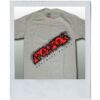
Life’s A Beach
Before the existence of the absolute crapfest that is NOFEAR, there was Life’s A Beach and the Bad Boy Club. Despite what it eventually morphed into through corporate buy-outs, Life’s A Beach was possibly the sickest clothing brand to emerge from the 80’s. Their beach/street clothing and prolifically hip marketing techniques conjured up images of perfect mini ramps, endless street spots, palm trees and warmer climates. The fact that they sponsored some of the best riders including Craig Campbell, Pete Augustine, Eddie Roman, and Brian Blyther probably boosted their image a lot too. Near the end, they produced some radical skate decks and hard shell knee pads under the BBC label. In 1989 they even took Pete Augustine and a few skaters on a North American tour doing street style demos at small bike and skate shops, introducing a whole new generation to street skating and BMX.


VISION STREET WEAR
Starting off as a skateboard deck brand and sponsoring several top skaters of the day including Mark Gonzales and Mark “Gator” Rogowski, Vision founder Brad Dorfman created the seminal urban clothing brand, Vision Street Wear. Sporting an unforgettable logo and producing shoes, pants, shorts, hip sacks, and of course, t-shirts, VSW quickly became fashionable for skaters and BMXers in the late 80s. VSW ran multiple ads in every magazine, sponsored top riders like Mike Dominguez and Ron Wilkerson, hooked up the entire GT and Dyno teams at one point, and even co-sponsored the highly visible 2-Hip King of Vert Contest series. It’s weird to think about now, but Vision Street Wear was a genuine phenomenon, growing to gigantic proportions seemingly overnight. But, to be honest, by the time I really got into BMX, I thought there was something a little corny about VSW. As the 90s rolled around, Vision had already had the stench of corporate fruitiness floating about for a few years. Things were changing rapidly and Vision seemed to represent a by-gone era of pop-glam-neon and 80s over-indulgence. Mark “Gator” Rogowski got sent to prison for 1st degree murder, Mark Gonzales quit the team to start his own skate company (called Blind, ironically), and Vision faded away from BMX around 1991. The brand still exists today however, and they even sponsor a few riders.
2HIP

The shirt maybe sums up an era better than any other - the classic 2HIP KOV shirt.

2Hip Logo shirt.
2-Hip – In the pre-Pork era, 2-hip was primarily known for their half pipe and early street contest series. However, Ron Wilkerson’s baby also produced a several popular T-shirt designs. The “Screaming Man” and the “65 MPH” designs were worn on quite a few backs, and the 2-Hip “Logo T” was one of the most recognizable shirts of the late 80’s. It would probably still sell today if Ron could put down the açaí long enough to get a few printed up.
STEP


In the early 90s, you’d be hard-pressed not to find any real-deal Northeast U.S. racer/ trails rider wearing a Step T-shirt or with a bike emblazoned with a Step sticker. The iconic STP rip-off logo and infamous tongue-in-cheek long-sleeve “Practice Jersey” (seen on many ahead-of-the-fashion-curve racers during Friday practice at any given East Coast national) were two of the most notorious designs that help put Step on the underground radar. And Tedd Nelson’s eye for creating cutting edge graphics put all of the Step offerings at a level that would be arguably ahead of its time even two decades later. When you had someone like the Blue Falcon rocking your shit, you must’ve been on to something.
The Best of the Rest...
FUSE CONCEPTS: East Coast rider Trent Chavez was the man behind this endeavor, and aside from an awesome name and some equally cool t-shirt designs, Fuse deserves an honorable mention for producing a very early promotional video called Flying a Kite in a Lightning Storm. I never saw the video, (and don’t know anyone who has) but the title alone is pure gold.
JINX CLOTHING:I don’t know a lot about these guys, except that they had a tent set up at every BS comp from 93 to 95, and seemed to be selling a lot of t-shirts, hats, shorts, and shin pads. They also sponsored Jay Miron, Day Smith, Chase Gouin, Paul Osicka, and Troy Mcmurray. Sounds like a perfect plan for mid 90s BMX success doesn’t it? Strangely, after sending Miron on a whirlwind European summer tour and releasing the Ells Bells directed video Velvet Taxi, we never heard anything from the company again. I think they were from Arizona, so maybe some locals can hit us up and clue us in on more details.
ON EDGE: This was Kansas City freestyle powerhouse Dennis McCoy’s supplemental mechanism for paying his travel expenses and entry-fees at contests during the lean years of the late 80s and early 90s. I don’t know if On Edge ever had more than one or two designs, but you could usually catch DMC and Rick Thorne selling t-shirts and stickers at AFA and 2-Hip events throughout the country.
LA RIDERS WEAR: Brilliant LA Raiders football team logo knock-off. Flatlander Bill Newman sold a ton of these puppies to hardcore flat, ramp and street riders for a couple of years. However, Henry Davis at East County BMX in San Diego says he refused to wear one because he was never a Raiders fan.
RIDE ON: During the production of Ride On, Eddie Roman printed up tons of T-shirts to get the word out about the video. These things were all over the place for a couple of years. A genius promotional move and an awesome design has Chad Herrington’s stretched nothing ingrained into BMX’s collective subconscious.
About that intro photo...

Steve Crandall and Woody Itson are as unlikely a mix as you'll ever see. We asked Crandall how the hell this shot ever came about and heres' what he had to say... "I met him at the Kansas City BS contest in like 93-94. We drove all night and slept in an abandoned 18 wheeler. I asked him to wear one for a photo and he was nice enough to humor me. I don't recall if he even ended up with it... I probably tried hustling him for ten bucks."
Previous
The Most Influential* BMX T-Shirt Companies of the 80's & 90's - PART 1
*Well, some of them...
Next
The Second Coming of the Nude Bowl
"so if you ever wanted a piece of BMX history, it’s there for the taking…Or is it?"
Related Content













